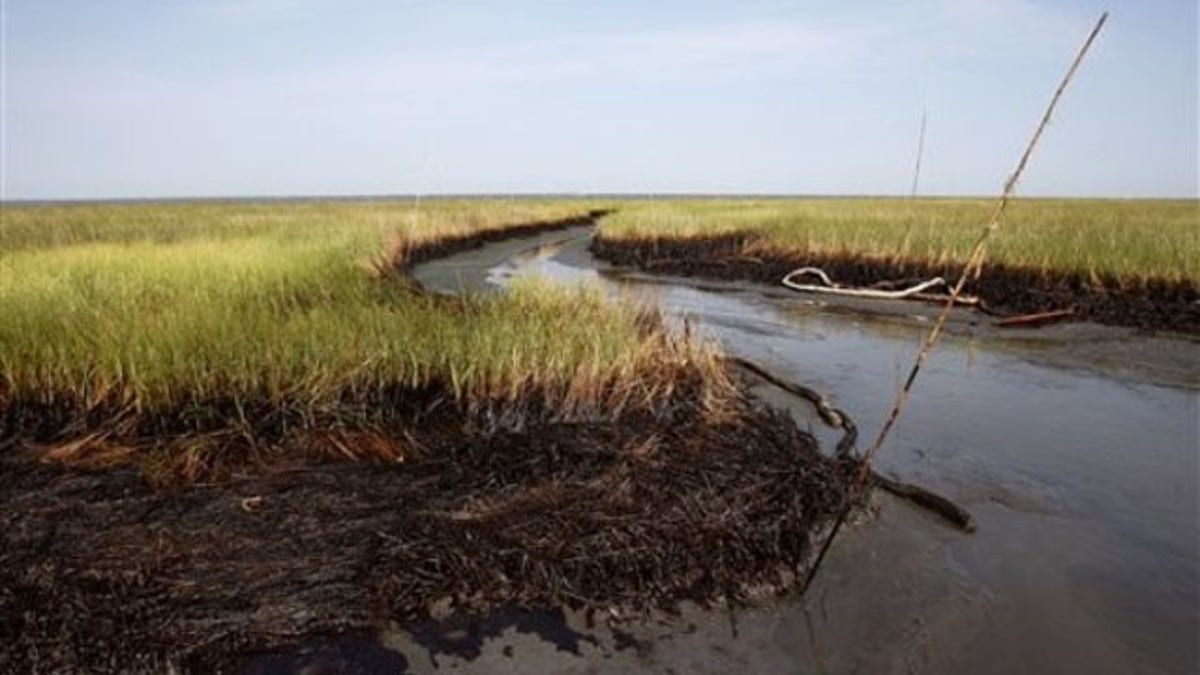
July 31: Oiled marsh grass is seen in Barataria Bay on the coast of Louisiana. As the National Oceanic and Atmospheric Administration reports that most surface oil in the Gulf of Mexico has degraded to a thin sheen and the incoming BP PLC CEO calls for a "scaleback" in cleanup efforts, local officials on the Louisiana coast say they are still finding new patches of heavy oil (AP).
A government report that concludes only 10 percent of oil from the Gulf of Mexico gusher was burned or skimmed does not earn BP a "passing grade," the Democratic chairman of a House subcommittee said Thursday.
Rep. Ed Markey, D-Mass., chairman of a House Subcommittee on Energy and Environment, said in a hearing Thursday that the 10 percent that BP was able to remove from the ocean by burning or skimming is no better than recovery efforts 21 years ago during the Exxon Valdez disaster in Alaska.
"It seems to me that BP's oil recovery effort comes in on the low effort of what was achievable 21 years ago," Markey said, pointing to both a Government Accountability Office and Office of Technology Assessment report that found -- given technologies available at the time of the 1989 accident -- only 10 to 15 percent of the spilled oil could be recovered..
"In my mind, that is not a passing grade, only 10 percent of the 4.1 million barrels actually having been recovered," he continued. "I think we all saw this coming...I think it's important that, even using a 21-year-old grading system, that BP has done a very poor job in cleaning up the Gulf."
Markey convened Thursday's hearing to press government officials on the state of the BP oil cleanup. Bill Lehr, a senior scientist with the National Oceanic and Atmospheric Administration, testified that one quarter of the gusher was recovered, burned or skimmed from the beaches or in the Gulf. Another quarter evaporated or degraded, one quarter ended up "dispersed" in the water column and one quarter is still floating around.
Another 800,000 barrels of oil were pulled directly from the well to ships, explaining the difference between the 4.1 million barrels determined to have gone into the Gulf water and 4.9 million barrels that gushed out of the well overall during the spill that lasted three and half months.
NOAA released a five-page report Aug. 4 that claimed "a vast majority" of the BP oil spill is now completely gone. The remaining 25 percent, the report said, consists of residual oil that is buried in sediments and sand in the water or along the shoreline.
The government report, however, is undermined by scientific data that found an oil plume at least 22 miles long, 3,000 feet deep in the Gulf of Mexico -- suggesting that the tens of millions of gallons of oil that leaked from a broken BP well could persist far longer than expected.
Whether the plume's existence poses a significant threat to the Gulf ecosystem and sea life is not yet clear, the researchers say.
"We don't know how toxic it is," said Christopher Reddy, a Woods Hole Oceanographic Institute (WHOI) marine geochemist and oil spill expert and one of the authors of a study conducted from observations made in late June.
Researchers and scientists as well as environmental groups and Gulf residents were quick to disagree with the NOAA report, calling it "misleading if not totally inaccurate."
But Reddy said he can't say "how much oil is in the plume" so the information doesn't necessarily contradict the government report.
The Obama administration used the Aug. 4 report to claim that 75 percent of the spill is gone and only one-quarter of the oil that began gushing after the April 20 accident remains in the water.
Rep. Darrell Issa, R-Calif., a chief critic of the White House, called those claims irresponsible since NOAA hasn't completed its evaluation.
"This is yet another in a long line of examples where the White House's preoccupation with the public relations of the oil spill has superseded the realities on the ground," Issa, who is ranking Republican on the Government Reform and Oversight Committee, said in a statement.
"It is deeply troubling that White House officials apparently preempted the completion and review of a scientific study on the oil spill by NOAA scientists in order to tout conclusions that many experts believe may be deeply flawed," he added.
On Thursday, Markey told Lehr that his testimony gave a "false sense of confidence" on the cleanup and long-term consequences to the environment.
"People want to believe that everything is OK and I think this report and the way it is being discussed is giving many people a false sense of confidence regarding the state of the Gulf," he said.
Lehr did not disclose in his testimony the methodology used to determine how much oil was released into the Gulf. He said his office will release the formulas and methodologies in about two months, after it has determined that its figures are correct.
That news angered Markey.
"You should not have released it until you knew it was right. If you are not confident that it is right then it should not have been released because it basically sent a signal with regard to how much of the problem remains," he said.
"The public has a right to know right now what's going on in the Gulf of Mexico. Because if your numbers are wrong, it could be too late," he added. "You don't want to give us all of the data. But you've given us conclusions."
FoxNews.com's Jeremy Kaplan contributed to this report




